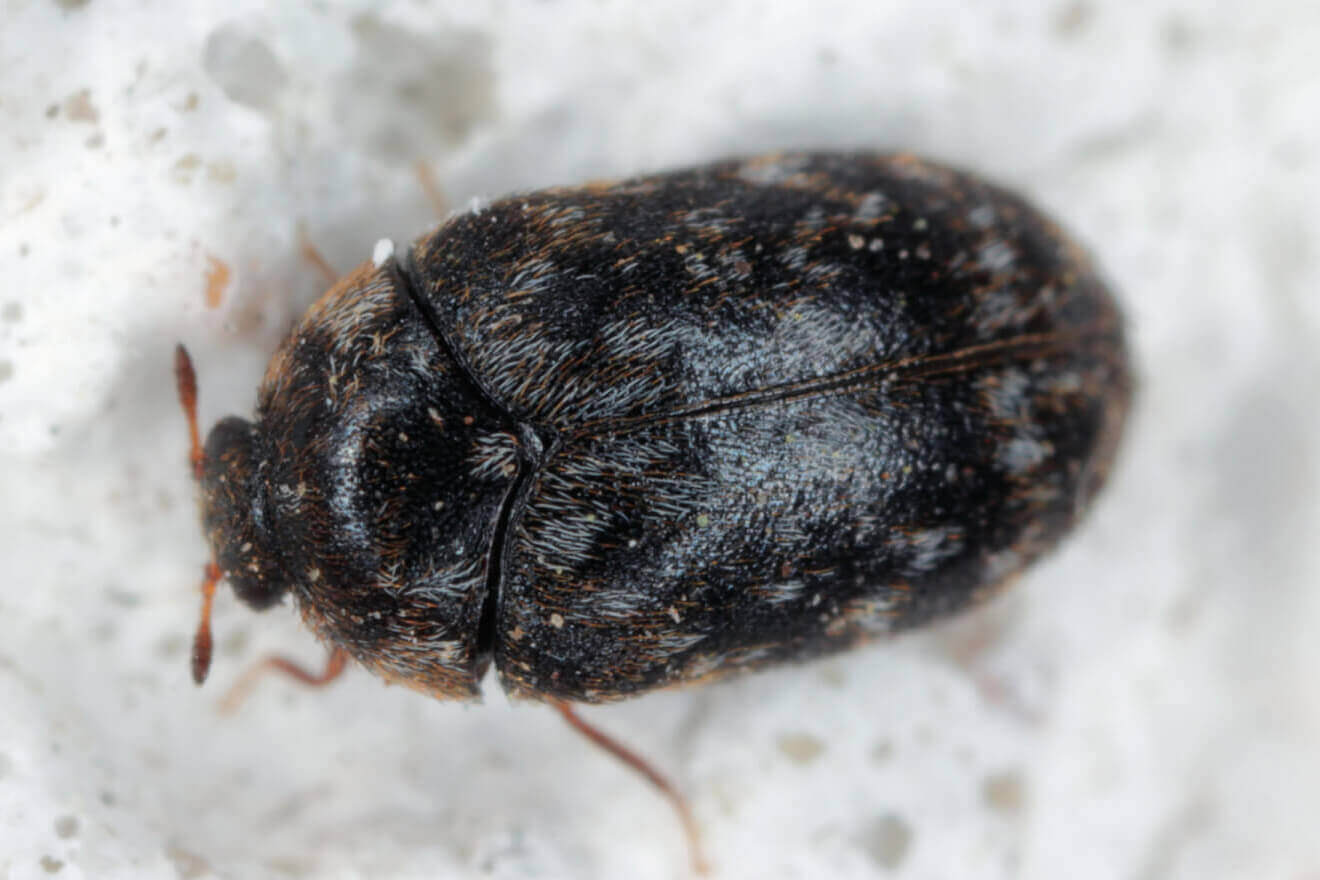Warehouse Beetle Facts & Information
Everything you need to know about warehouse beetles
what do warehouse beetles look like

These beetles are about ⅛ of an inch long with oval-shaped bodies that are black or brown in color though some warehouse beetles may appear mottled. They will have three lines across their bodies that are either gray, gold, or reddish-brown. Their outer wings, the elytra, are hair-covered and generally dark in color, with bands that vary from brown to red. Larvae are yellowish-white but grow darker as they mature. The larvae of the warehouse beetle can grow up to a 1/4 inch in length and are distinguishable by the tufts of hairs that line the body.
The most common sign of a warehouse beetle infestation is the presence of the molted skins that the larvae cast off as they pass through the various larval instars and before pupating. A sighting of several adult warehouse beetles is indicative of an infestation, though the extent of the problem may vary. Finding larvae in stored food proves the presence of the invading insects, as well. No matter what they look like, though, you’re going to want a beetle exterminator to help with them.
Females lay around 90 eggs in a lifetime, and the resulting offspring go through a life cycle that takes anywhere from two to four months to complete. In cases of food shortages or poor environmental conditions, warehouse beetle larvae can slow their development by molting numerous times before deciding to pupate. This extends the larval stage of the life cycle and helps ensure the survival of developing warehouse beetles, and thus the success of the species. In fact, warehouse beetle larvae have been known to remain in suspended development for over a year in unfavorable conditions. Pupation occurs directly on a food source to allow the emerging adults to mate immediately. Adults live anywhere from a few days to a few months, depending on the temperature of the environment.Not the beetle you have?
The most common sign of a warehouse beetle infestation is the presence of the molted skins that the larvae cast off as they pass through the various larval instars and before pupating. A sighting of several adult warehouse beetles is indicative of an infestation, though the extent of the problem may vary. Finding larvae in stored food proves the presence of the invading insects, as well. No matter what they look like, though, you’re going to want a beetle exterminator to help with them.
Females lay around 90 eggs in a lifetime, and the resulting offspring go through a life cycle that takes anywhere from two to four months to complete. In cases of food shortages or poor environmental conditions, warehouse beetle larvae can slow their development by molting numerous times before deciding to pupate. This extends the larval stage of the life cycle and helps ensure the survival of developing warehouse beetles, and thus the success of the species. In fact, warehouse beetle larvae have been known to remain in suspended development for over a year in unfavorable conditions. Pupation occurs directly on a food source to allow the emerging adults to mate immediately. Adults live anywhere from a few days to a few months, depending on the temperature of the environment.Not the beetle you have?
How Did I Get Warehouse Beetles
Unfortunately, warehouse beetles usually come from infested food that you unwittingly chose right off the grocery store shelf. It’s not anything you’re doing at your business or home. If warehouse beetles have found their way into your pantry, then the first step is to throw away any infested food and perform a deep cleaning. Dispose of any food that may have been contaminated first. Then take all the remaining uncontaminated items out of your cabinets or pantry so you can deep clean the shelves. If you have shelf liner, throw it away and clean where it was. Don’t forget to vacuum the cracks behind your molding. It only takes a few grains of food to attract a population of warehouse beetles. Once everything is clean and you’re ready to restock, store food in tightly sealed containers made of glass or hard plastic. Note the brand of food you purchased that was infested and let your local grocery store know. And of course avoid that brand in the future.
Where Do Warehouse Beetles Live
True to their name, adult warehouse beetles are especially common in food processing facilities and warehouses. Warehouse beetles thrive in temperate environments and can be found anywhere from large-scale grain production facilities to home pantries. Even though warehouse beetles are commonly found in flour and feed mills, warehouses, dried milk factories, stored-grain facilities and distribution centers, and processing plants, they can also be found in pantries in homes and businesses. Warehouse beetles have even been known to infest the nests of bees, rodents, and birds as well.
What Problems Do Warehouse Beetles Cause
Warehouse beetles are not known to bite or sting humans, but they will destroy your dried pantry items. Warehouse beetles will happily eat oatmeal, cereal, corn, flour, pet food, and many other dry foods. The larvae of the warehouse beetle may also cause problems. Warehouse beetle larvae can wreak havoc in pantries and businesses, chewing through most protective wrappings, including plastics and aluminum foil, and ruining food products. In homes, this can leave them inedible. In businesses, this can have a serious financial impact.
The setae, or shape hairs, on the body of the larvae can also cause gastrointestinal irritation in infants, children, and susceptible individuals, resulting in vomiting and diarrhea. This includes your pets! For extremely sensitive individuals, the hairs can also cause an allergic reaction. Let us come in and handle the beetle treatments that will ultimately get these beetles under control.
The setae, or shape hairs, on the body of the larvae can also cause gastrointestinal irritation in infants, children, and susceptible individuals, resulting in vomiting and diarrhea. This includes your pets! For extremely sensitive individuals, the hairs can also cause an allergic reaction. Let us come in and handle the beetle treatments that will ultimately get these beetles under control.
How Do I Prevent Warehouse Beetles
It’s very difficult to prevent warehouse beetles since they usually come in inside an infected package of food. If you do get them, you can prevent them from growing. Monitor and inspect all possible food sources and discard any infected products. Take everything out of the pantry and do a deep clean. Thoroughly vacuum cabinets, shelving, and crevices to make sure you don’t miss any warehouse beetles. Use stored foods with earlier expiration dates first (first in first out!). Don’t mix older food products with newer ones. If you do purchase something infested with red flour beetles, make sure to report it to wherever you bought it and avoid that brand going forward. Good sanitation practices and keeping dried foods in sealed, air-tight containers will help keep the infestation from growing, but keeping them out entirely is not an easy task.
Why Waltham for Warehouse Beetle Control
We’re passionate about keeping warehouse beetles out of your home or business because we live and work here – it’s our neighborhood, too. With our 130 years of experience keeping homes and businesses in Massachusetts, Connecticut, New York, Maine, Vermont, New Hampshire, and Rhode Island safe from pests, Waltham has the experience you can trust.
Satisfaction Guarantee
24-Hour Guaranteed Response
Board Certified Entomologists
Need help with warehouse beetles?
GET MY QUOTE
